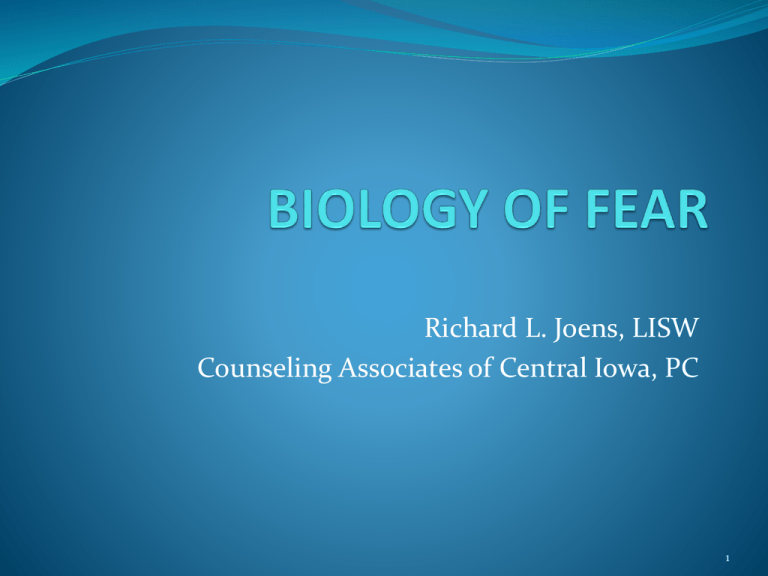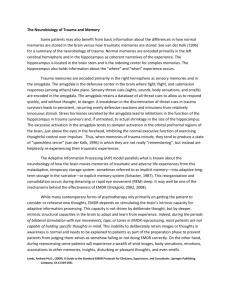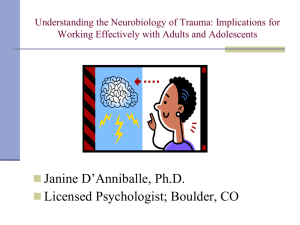biology of fear - Crossroads of Iowa
advertisement

Richard L. Joens, LISW Counseling Associates of Central Iowa, PC 1 Moments of overwhelming terror can alter brain chemistry for decades Persons with Post-Traumatic Stress Disorder (PTSD) complain of almost unbearable states of physiological arousal, emotional hypersensitivity, exaggerated startle response and distorted memories 2 They experience: Sleeplessness Hypervigilance Numbness Withdrawal Amnesia Flashbacks 3 Their brains are not working the way they use to before the trauma occurred They wonder if they are going crazy They feel misunderstood and embarrassed They get irritable and angry They shun public places and interactions with other people 4 During a traumatic incident, the neurotransmitters released by the brain’s limbic system (specifically the amygdala) signal an alarm to the autonomic nervous system These hormones activate one of the branches, the sympathetic nervous system (SNS), to extreme arousal, fight and/or flight 5 Blood flows away from the skin and viscera and into the muscles for quick movement Heart rate, respiration and blood pressure all rise to give the muscles more oxygen The eyes dilate to provide sharper distant sight 6 When fight or flight are not possible, the limbic system may further signal the autonomic nervous system (ANS) to simultaneously activate its other branch, the parasympathetic nervous system (PNS) The SNS continues its extreme arousal while the PNS freezes the action of the body 7 Body sensations slow down and emotions are numbed People who have survived mauling by animals or falls from great heights report that this kind of dissociation reduces the physical pain and emotional terror during such experiences 8 Stress hormones: epinephrine and norepinephrine (also known as adrenaline and noradrenaline) increase the brain’s alertness, enhance memory and quicken the heartbeat People can do extraordinary things during the “adrenaline rush” 9 When stress becomes overwhelming, too much epinephrine and norepinephrine induce confusion and impair learning and memory At high enough levels, these fight or flight hormones induce amnesia 10 Repeated secretions of the stress hormones progressively sensitize brain chemistry provoking ever greater floods of stress hormones at LOWER thresholds This sensitization can last for many years What may be ordinary stress to non-traumatized persons will push trauma survivors over the edge 11 Persons with childhood abuse histories are significantly more likely to develop PTSD from traumas in later years PTSD Veterans were found to have chronically elevated levels of stress hormones years after combat The same was true of sexually abused girls (7-14 years old) 12 Another part of the limbic systems that plays a major role with traumatic experiences is the hippocampus Back to the amygdala and example of seeing a snake The cortex evaluates the situation with rational thought and sends an appropriate message to the amygdala 13 The hippocampus assists the transfer of the initial information [the image of the snake] to the cortex The hippocampus is vulnerable to stress hormones They suppress the activity of the hippocampus and it stops functioning A rational evaluation of the situation is not possible 14 The hippocampus is also a key structure in facilitating resolution and integration of traumatic incidents and memory It inscribes time context on events A well-functioning hippocampus makes it possible for the cortex to recognize when a trauma is over, perhaps even long past Then it instructs the amygdala to stop sounding the alarm 15 Floods of epinephrine and norepinephrine are linked to flashbacks PTSD survivors have demonstrated a 30% drop in pain sensitivity; their brains released natural opiates with the pain killing equivalent of eight milligrams of morphine, which may correlate with the reported numbness 16 Animal researchers have found a link between high cortisol (stress hormone) levels over a period of weeks and the withering of dendrites (the feathery branches that allow brain cells to form communication pathways and associational networks with hundreds of thousands of their neighbors) This may be associated with dissociation 17 THERAPEUTIC IMPLICATIONS Successful trauma therapy must maintain stress hormone levels low enough to keep the hippocampus functioning Therapists can watch for physical signals of autonomic system (sympathetic) arousal: tone of voice, skin turning pale, breathing quickly, panting, dilated pupils, shivering, feeling cold, etc. 18 Time to calm the client down Help the client pay attention to body sensations Directly engage the cortex: “Can you see me? Clearly? Describe me.” Notice changes in your body, etc. EMDR 19 OVERVIEW OF EMDR Does the client present with symptoms of PTSD? Establish rapport and outline what EMDR is Answer questions Establish targets: “What comes to mind when you think about the trauma?” 20 Determine negative cognition: “What negative belief do you have about yourself when you think about the trauma?” Use SUD scale to evaluate intensity Determine positive cognition: “What would you rather believe about yourself when you think about the trauma?” Use SUD scale to evaluate how much they believe this statement now 21 “What emotions come up when you think about the trauma?” Use SUD scale to evaluate intensity “What do you feel in your body when you think about the trauma?” Establish safe place resources and practice eye movement – use tappers or sound substitutes as needed 22 Begin focusing on the target with eye movement Monitor the movement of the eyes – include appropriate encouragement as needed Stop the movement, breathe, ask client what came up Continue focusing on what comes up and do more sessions of eye movement 23 Be aware of parts stepping in to protect client from proceeding – ask the part if it will step back, etc. Use adult/resource interventions as needed Use SUD scale as needed Does the client feel like he or she is done with this target? 24







